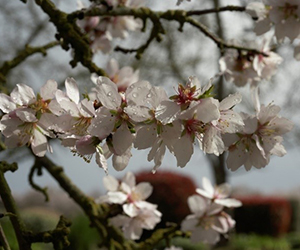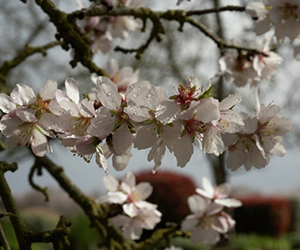With long-term water supplies constantly on farmers’ minds, you won’t find many complaining about the wet start this year – each rainy day brings with it a chance to build snowpack in the mountains, fill reservoirs and replenish underground aquifers.
Still, precipitation during the onset of bloom can mean serious challenges for almond growers.

“Rain in 2019, from early bloom until now, really made things complicated in terms hampering bee hours and ensuring healthy flowers can grow,” said Sebastian Saa, senior manager for Agricultural Research at the Almond Board of California (ABC).These concerns mean that growers need to pay special attention to their trees, making precise adjustments as needed to keep trees in balance and ready to deliver a good harvest.
A rainy bloom generally requires applications of fungicides as part of a grower’s Integrated Pest Management plan.
“You often don’t need to apply if it doesn’t rain,” Saa said. “But if it is raining, you have to protect your flowers and your fruit to make sure they don’t get infected with all of the different fungi that are threatening to attack after it rains.”
Determining how well growers protected their flowers — and how well bees were able to pollinate — is now becoming apparent in many orchards. Almond trees naturally shed or “drop” fruit for a variety of reasons, ranging from fungus damage and frost to lack of pollination or competition within the tree itself.
Walking the orchards at the right times, observing the orchard floor and assessing the drops can help growers figure out where they are and what to do next.
Drop happens in three distinct stages, the first of which is shortly after bloom when defective flowers fall from the tree. The second drop occurs about a month later when pea-sized flowers, mostly unpollinated, fall. The third and final drop — referred to as “June drop” — occurs six to seven weeks after bloom.
“I’m optimistic that this year we won’t have a huge third drop. However, the first two drops might be rather telling because the weather conditions in March were not optimal," Saa said. Many orchards should be experiencing the second fruit drop now, so growers should walk their orchards to check how much fruit that is on the floor. They can also grab some branches and shake them to see how much fruit drops.
Fortunately, with a little help from the grower, the tree tends to balance itself.
The third drop is usually linked to competition within the tree for resources, especially water and nutrients. That competition — and the resulting drop — can be mitigated through proper management, so balancing the right amount of water and nitrogen is critical. For instance, too much water creates anoxic soil conditions, hurting root growth and the tree’s ability to take in adequate nutrients later in the season.
“The grower’s job is to provide what the tree needs to avoid fruit drop,” Saa said. “A little bit too much, or a little bit too little, can make a big difference.” Mid-April also presents the opportunity to take leaf samples, which tell the grower if the tree is getting enough nitrogen. It’s also a good time to make a yield estimate and refine nitrogen applications, as needed.
While it is always advisable to make irrigation and nutrient decisions relying on sound tools like the Almond Board’s Irrigation Continuum and Nitrogen Calculator, it’s even more important when nature brings challenging conditions because there is less room for error, Saa said.
“Be careful not to apply too much nitrogen,” he said, pointing out the potential consequences of excessive vegetative growth and reduced nitrogen use efficiency.


